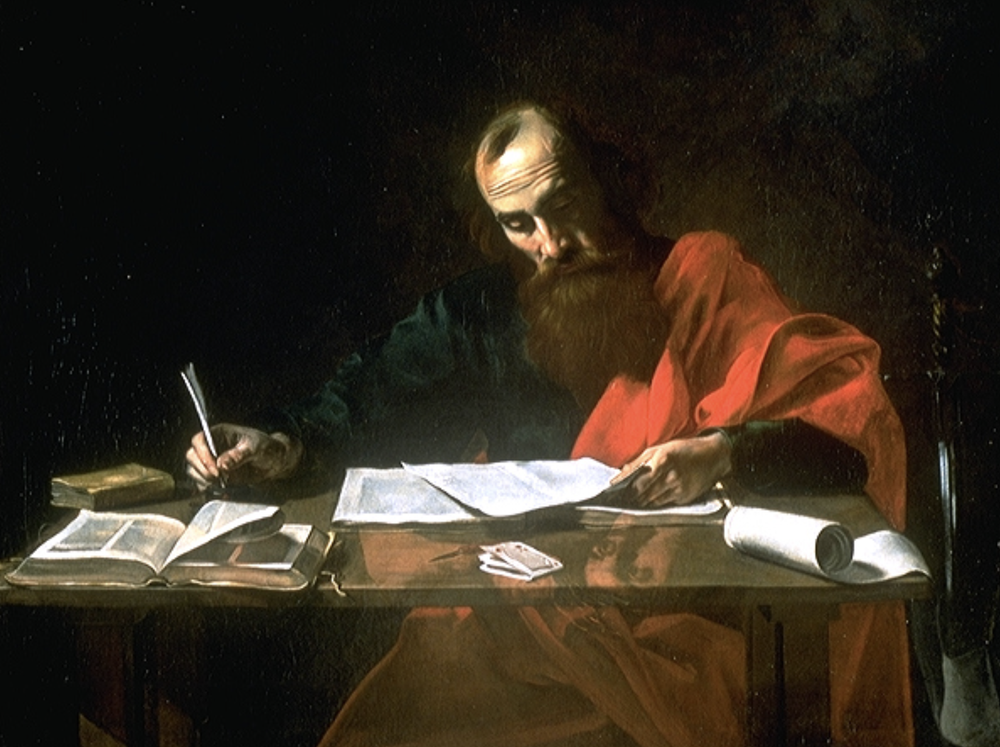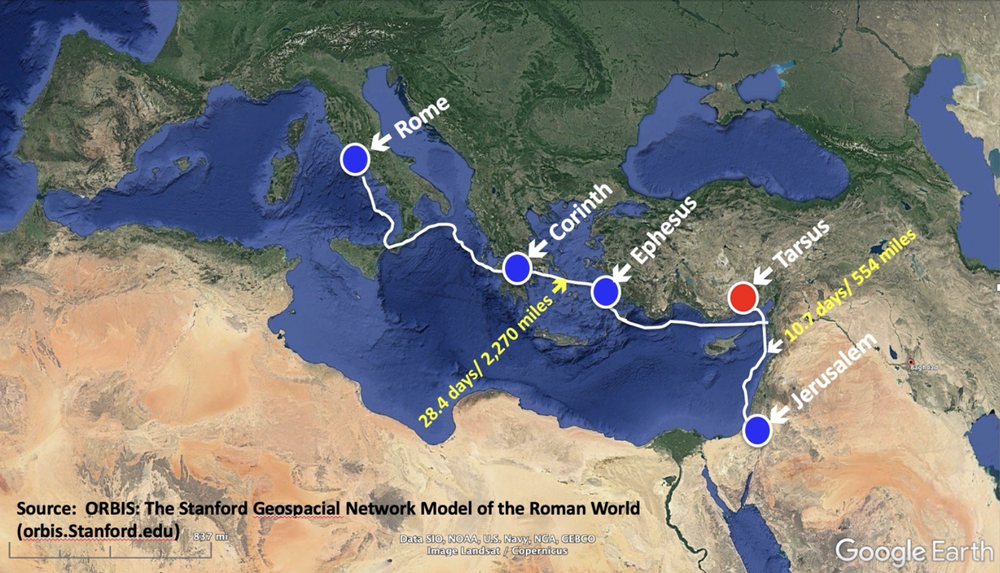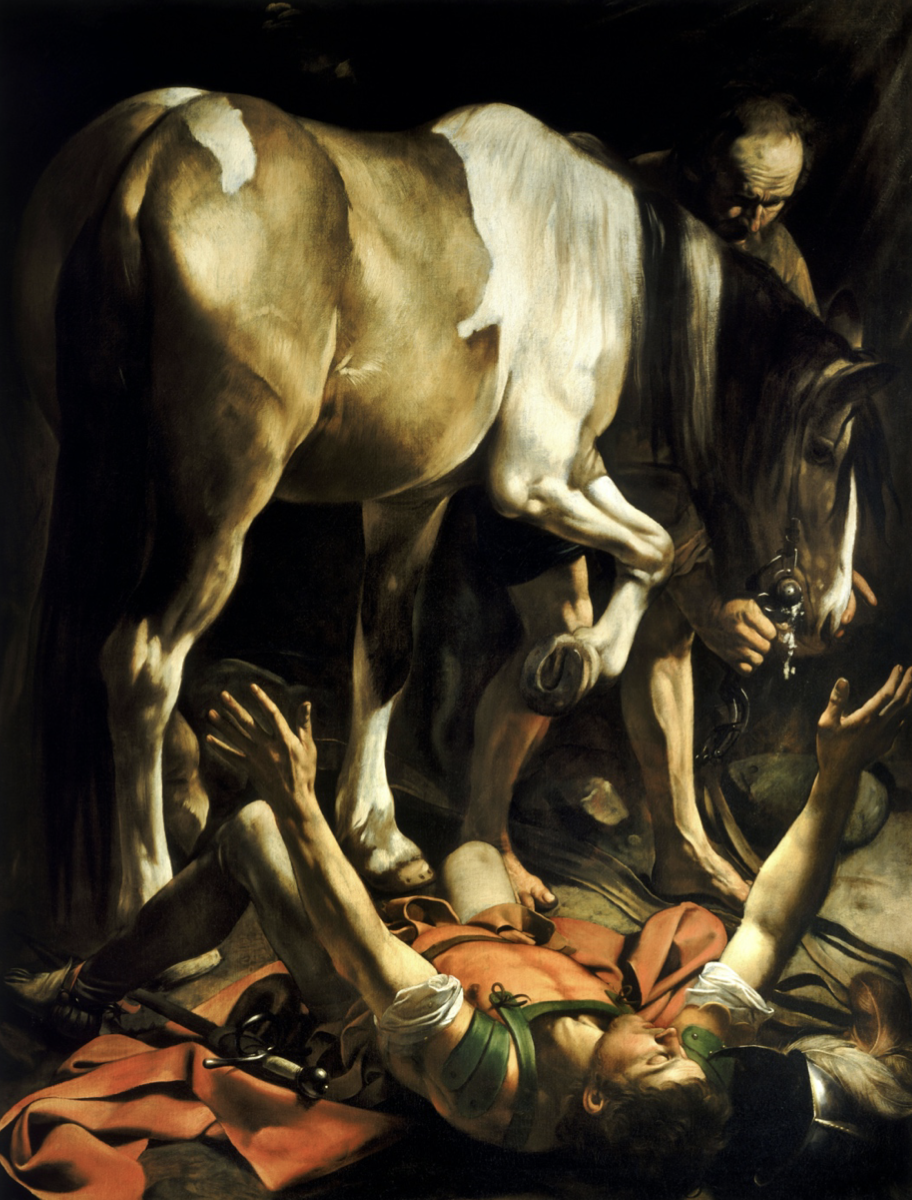Apart from Jesus himself, St. Paul is the most significant personality in the New Testament. But just who was Saul of Tarsus (AKA, St. Paul the Apostle)? Let’s take this opportunity to explore him together. Saul of Tarsus was...

Valentin de Boulogne. Saint Paul Writing His Epistles (oil on canvas), c. 1620.
Museum of Fine Arts, Houston.
Apart from Jesus himself, St. Paul is the most significant personality in the New Testament. But just who was Saul of Tarsus (AKA, St. Paul the Apostle)? Let’s take this opportunity to explore him together.
Saul of Tarsus was one of the most brilliant young men of his generation. Growing up in a wealthy family, receiving a world-class education, and being groomed for leadership at the highest levels of Judaism, Saul became the great persecutor of the emerging Church shortly after Jesus' death, burial, and resurrection. On the road to Damascus to round up Christians and have them brought back to Jerusalem for punishment, Saul encounters the risen and glorified Christ… and his life turns upside down.
In the wake of his conversion, Saul of Tarsus becomes St. Paul the Apostle. Singlehandedly, St. Paul evangelizes all of Asia Minor, a large part of Europe and he writes 13 of the 27 books of the New Testament. No slouch, our St. Paul! St. Paul's dramatic conversion and his evolution from the self-proclaimed “greatest of sinners” to one of our greatest of saints is one of Scripture’s best stories. Yet, St. Paul is one of the most complex—and often most misunderstood—people in the entire Bible.
When St. Paul is arrested in Jerusalem in A.D. 57, charged with inciting a riot and mistakenly identified as an Egyptian terrorist, he replies indignantly: “I am a Jew from Tarsus in Cilicia, a citizen of no ordinary city” (Acts 21: 39). Later, when he is about to be flogged, Paul asserts his Roman citizenship again in no uncertain terms, prompting an exchange with the Roman commander:
“Tell me, are you a Roman citizen?” “Yes, I am,” [Paul] answered. Then the commander said, “I had to pay a big price for my citizenship.” “But I was born a [Roman] citizen,” Paul replied.
(Acts 22: 27-28)
These two scenes speak volumes about St. Paul, and they tempt us to explore St. Paul’s background in more depth. What do we really know about St. Paul, and what informed assumptions might we make about St. Paul’s early, formative years?
In St. Paul’s day Tarsus was the leading city on the fertile plain of East Cilicia, located about ten miles from the mouth of the Cyndus River and about thirty miles south of the Cilician Gates.


A Roman street from Tarsus of St. Paul’s day.
Photography by Ana Maria Vargas
Tarsus came under Roman rule as a result of Pompey’s victories, becoming the capital of Cilicia and retaining its autonomy as a free city (67 B.C.). Cicero resided in Tarsus while serving as Procounsul of Cilicia (51-50 B.C.), and Julius Caesar visited the city in 47 B.C. After Caesar’s assassination in 44 B.C., Tarsus enjoyed the favor of Antony, and it was in Tarsus in 41 B.C. that the celebrated meeting between Antony and Cleopatra took place (recall the 1963 movie with Elizbeth Taylor and Richard Burton). Shakespeare describes the meeting best, as Cleopatra’s barge glides up the Cyndus River:
“The barge she sat in, like a burnish’d throne,
Burnt on the water. The poop was beaten gold,
Purple the sails, and so perfumed that
The winds were love-sick with them; the oars were silver,
Which to the tune of flutes kept stroke, and made
The water which they beat to follow faster,
As amorous of their strokes. For her own person,
It beggar’d all description: she did lie
In her pavilion—cloth of gold, of tissue—
O’er-picturing that Venus where we see
The fancy outwork nature. On each side her
Stood pretty dimpled boys, like smiling Cupids,
With divers-color’d fans, whose wind did seem to [glow] the delicate cheeks which they did cool, And what they undid did.”
(Antony and Cleopatra, II, ii, 191-204)
During the reign of Caesar Augustus (27 B.C. – A.D. 14) Tarsus enjoyed enormous privileges, including exemption from imperial taxation. An extremely prosperous city, Tarsus derived its wealth from the fertile plain on which it was located. Strabo, the Greek historian, geographer and philosopher writes in his Geography (xiv, 5. 12ff.) that Tarsus was a leading cultural and educational center, surpassing even Athens and Alexandria. Its people, he says, were avid in their pursuit of culture, applying themselves to the study of philosophy, literature, music and the whole round of liberal arts.
When Paul claims to be “a citizen of no ordinary city,” he certainly has justification for doing so. And as one “born a citizen,” Paul necessarily came from a well-to-do family. Roman citizenship was originally confined to freeborn natives of Rome, but as the Empire expanded citizenship was extended to other people in the provinces. Presumably, Paul’s father, grandfather or perhaps even great-grandfather had acquired Roman citizenship, either by making a significant contribution to the Roman Empire (militarily, or more likely, economically), or by purchasing Roman citizenship through political connections and cash. In addition, Dio Chrysostom (c. A.D. 40-115), in his Oration (34, 23), tells us that enrolling as a Roman citizen in Tarsus required owning property in excess of 500 drachmae—not an easy threshold to meet. Paul’s family clearly had both money and status.
Although nothing suggests that Paul’s family were assimilated Jews (quite the contrary, Paul claims to be “a Hebrew [born] of Hebrews; in regard to the Law, a Pharisee”—Philippians 3: 5), Paul was deeply exposed to Greco-Roman culture and Roman education. Paul’s letters evidence considerable training in classical rhetoric, and when he speaks at the Areopagus in Athens he supports his argument by deftly quoting from the 6th-century B.C. Cretan poet Epimenides (Acts 17: 28), a favorite of the Stoic and Epicurean philosophers to whom he is speaking. St. Paul most certainly knew his classical literature!
In St. Paul’s day, children of well-to-do families were taught by private tutors or at private schools. Primary education focused on the basics of reading and writing, using Roman literary works, especially poetry, as models. Between nine and twelve years old, students from affluent families would leave their primary education and continue the advanced study of Greek and hone their speaking and writing skills. At 14 or 15 years old the most promising students then focused on the study of deliberative or judicial rhetoric. Such boys were from exclusive, wealthy families and were being groomed for the highest levels of public office and commerce. One can only speculate on what level St. Paul reached, although clearly he was highly skilled in Greek rhetoric, easily adapting his speech and writing to his audience, suggesting that he had reached a very high educational level.
At some point in St. Paul’s education his family sent him to Jerusalem (accompanied perhaps by his sister—see Acts 23: 16) for advanced religious study. Like all upper-class Jewish young men, Paul had been well schooled in Scripture and Oral Law at the local synagogue, but once in Jerusalem Paul became a student of the greatest Rabbi of his century, Gamaliel (Acts 22: 3). The grandson of the great Hillel, Gamaliel was a leader of the Sanhedrin and possibly its President. Only the brightest and most promising student could possibly secure a position under such a man. St. Paul traveling from Tarsus to Jerusalem to study under Gamaliel is like Beethoven traveling from Bonn to Vienna to study under Joseph Haydn, or like a newly minted Cal Tech Ph.D. in physics traveling from Pasadena to Cambridge for a post-doctoral fellowship under Stephen Hawking.
Paul had an extraordinary education, available only to the brilliant son of a wealthy and influential family. Born into privilege as a Jew and a Roman citizen, Paul was steeped in both secular and religious education; he was fluent in at least four languages: Hebrew, Aramaic, Greek and Latin; he was being groomed for leadership in the Sanhedrin; and he was absolutely committed to his beliefs. F. F. Bruce suggests in Paul, Apostle of the Heart Set Free (Grand Rapids, MI: William Eerdmans Publishing Company, 1977, rev. ed., 2000) that even if the events on the road to Damascus had never happened, history would still know of Saul of Tarsus: he was destined for greatness. [1]
So, Saul of Tarsus was an extraordinarily well-educated young man, living in Jerusalem at the time of Jesus. He was an adult student of the great Gamaliel, and he had access to the leaders of the Sanhedrin and to the high priest himself. He was the rising young star in Judaism. So, what caused his intense hatred of Jesus and the Church? As he himself says to king Agrippa: “I was so enraged against them that I pursued them even to foreign cities” (Acts 26: 11). The Greek word “enraged” is ??????????, a compound of ?? (“in”) and ???????? (“behave as manic”); that is, “locked in a frenzy of rage,” a very intense and visceral emotion.
Perhaps it began at Passover, A.D. 32, when Jesus rides into Jerusalem on the day we call “Palm Sunday.” Recall the story in Luke 19: 28-40:
“[Jesus] proceeded on his journey up to Jerusalem. As he drew near to Bethphange and Bethany at the place called the Mount of Olives, he sent two of his disciples. He said, ‘Go into the village opposite you, and as you enter it you will find a colt tethered on which no one has ever sat. Untie it and bring it here. And if anyone should ask you, ‘Why are you untying it?’ you will answer, ‘The Master has need of it.’ So those who had been sent went off and found everything just as he had told them. So they brought it to Jesus, threw their cloaks over the colt, and helped Jesus to mount. As he rode along, the people were spreading their cloaks on the road and now as he was approaching the slope of the Mount of Olives, the whole multitude of his disciples began to praise God aloud with joy for all the mighty deeds they had seen. They proclaimed:
‘Blessed is the king who comes in the name of the Lord.
Peace in heaven
and glory in the highest.’
“Some of the Pharisees in the crowd said to him, ‘Teacher, rebuke your disciples.’ He said to them in reply, ‘I tell you, if they keep silent, the [very] stones will cry out.’”
The words of the crowd are incendiary! Luke draws on Matthew and Mark for the words of the crowd, a quote from Psalm 118: 26, but only Luke adds the word “king” to the quote, making explicit the crowd’s proclamation of a new king, one representing a new kingdom. Jesus’ “triumphal entry” deliberately recalls Solomon’s entry into Jerusalem, when David elevates him to the throne in 1 Kings 1: 38-40.
Was Saul of Tarsus there on the “Palm Sunday” road as Jesus passed by?
As the rising young star in Judaism, Saul had a vested interest in maintaining and defending the status quo, and Jesus’ actions are blatantly inflammatory, if not treasonous. That is only reinforced when Jesus arrives at the southern steps of the Temple with a whip, driving out the merchants and money changers, shouting: “It is written, ‘My house shall be a house of prayer, but you have made it a den of thieves’” (Luke 19: 46).
Was Saul of Tarsus there at the southern steps?
The next day the religious leaders confront Jesus and demand: “By what authority are you doing these things? Or who is the one who gave you this authority?” Jesus replies: “I shall ask you a question. Tell me, was John’s baptism of heavenly or of human origin?” After discussing it, the religious leaders say, “We don’t know.” And Jesus says, in effect, “I didn’t think so!” This exchange publicly humiliates the religious leaders, and we can only imagine the crowds guffawing at them as the religious leaders are taken aback.
Was Saul of Tarsus one of the religious leaders; was it he who responded: “We don’t know”?
Jesus presses the attack, regaling the crowds with the parable of the “tenant farmers,” a scathing indictment of the religious leaders. Once more the crowds cheer him on, and the religious leaders can do nothing, for the crowds are huge, and they hang on Jesus’ every word, delighted at Jesus’ audacity and his rapier wit in skewering the corrupt authorities.
Was Saul of Tarsus a target of Jesus’ comments?
Next, the religious leaders “sent agents pretending to be righteous who were to trap him in his speech,” discrediting him before the crowds. It would take a very clever man to do so.
The most clever of them all asks, “Is it lawful for us to pay tribute to Caesar or not?”—knowing that answering either “yes” or “no” would discredit him before the crowds or get him arrested by the Roman authorities. Jesus then asks the questioner for a coin; the man tosses it to him, and Jesus displays Caesar’s picture on the coin—a coin Jews may not bring into the Temple precincts, but this particular religious leader had a pocket-full of them.
Did Saul of Tarsus toss Jesus the Roman coin?
When Judas led a crowd to the Garden of Gethsemane to arrest Jesus, was Saul of Tarsus among them?
Although Saul was not yet a member of the Sanhedrin, was he present (perhaps as an assistant to Gamaliel) at the home of the high priest, Caiaphas, during Jesus’ trial?
When Jesus was accused before Pilate at the Antonia Fortress, did Saul of Tarsus lead the shouts of the crowd: “Crucify him!”?
On the cross we read that “The people stood by and watched; the rulers, meanwhile, sneered at him and said, ‘He saved others, let him save himself if he is the chosen one, the Messiah of God’” (Luke 23: 35).
Was Saul of Tarsus among them; did Saul of Tarsus say the words?
Finally, when Stephen stands before the Sanhedrin, speaking boldly against the Temple and the law of Moses—deeming both irrelevant—and then when he accuses the high priest and religious leaders of the betrayal and murder of Jesus—does that finally push Saul over the edge, triggering his own murderous rage? With Stephen’s words, the entire Sanhedrin “rushed upon him together. They threw him out of the city, and began to stone him. The witnesses laid down their cloaks at the feet of a young man named Saul” (Acts 7: 57b-58). Make no mistake, Saul was no idle bystander: he supervised the stoning of Stephen, giving his hearty approval [??????????] of the deed.
Saul then spearheaded the persecution of Jesus’ followers in Jerusalem, “entering house after house and dragging out men and women, he handed them over for imprisonment” (Acts 8: 3). Not satisfied, Saul, “still breathing murderous threats against the disciples of the Lord, went to the high priest and asked him for letters to the synagogues in Damascus, that, if he should find any men or women who belonged to the Way, he might bring them back to Jerusalem in chains” (Acts 9: 1-2). Saul could not have had access to the high priest—let alone receive letters delegating the high priest’s authority to act on his behalf—if he were not a significant, rising star within the Jewish leadership.
But then on the road to Damascus, everything changed—in a blinding flash of light!

Caravaggio. Conversion on the Way to Damascus (oil on canvas), c. 1600-1901.
Santa Maria del Popolo, Rome.
After three days of blindness, Saul’s eyes are opened—both literally and figuratively. Saul’s entire life had been turned upside down, and he spent those three days in sheer agony, traumatized physically, spiritually and emotionally. Later, St. Paul confesses to his young prote?ge?, Timothy: “This saying is trustworthy and deserves full acceptance: Christ Jesus came into the world to save sinners. Of these I am the foremost” (1 Timothy 1: 15-17).
It is this understanding—that Saul is the greatest of sinners, a persecutor of Christ and a murderer of Christians—that drives his life relentlessly from that moment onward. All of St. Paul’s profound learning, his unflagging energy and stamina, his intellectual and spiritual prowess—and the grace of God—set him on the road to sainthood. It was a long and very difficult journey, but writing from “death row” in A.D. 68 in Rome’s Mamertine prison, St. Paul opens his heart to Timothy:
“For I am already being poured out like a libation, and the time of my departure is at hand. I have competed well; I have finished the race; I have kept the faith. From now on the crown of righteousness awaits me, which the Lord, the just judge, will award to me on that day, and not only to me, but to all who have longed for his appearance.”
(2 Timothy 4: 6-8)
St. Paul is martyred in Rome during the A.D. 64-68 persecution under the emperor Nero. As a Roman citizen, Paul was not crucified, as was Jesus and St. Peter; rather, he was beheaded and his body buried outside the city walls. Today the Basilica of St. Paul Outside the Walls sits over his remains, which are enclosed in a white marble sarcophagus.

Enrique Simonet. The Beheading of St. Paul (oil on canvas), 1887.
Malaga Cathedral, Malaga, Spain.
Notes:
[1] One might argue that since St. Paul was a tentmaker [??????????] (see Acts 18: 3) he was necessarily poor. Although highly educated, St. Paul—like most Jewish boys—learned a trade, as well. Every Jew, both then and now, knows that a beautiful home in Beverly Hills, a condo in Maui and a flat in London can vanish overnight. Witness the prosperous Jews of Berlin in 1939. St. Paul only exercises his trade as an entry into the Corinthian community, working only briefly with Priscilla and Aquila.









